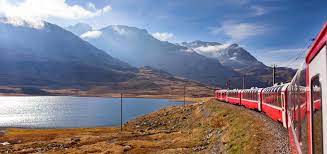
Travelling by Train: A Convenient and Eco-Friendly Option
Trains have long been a popular mode of transportation, offering a unique travel experience that combines convenience, comfort, and sustainability. Whether you’re commuting to work or embarking on a leisurely journey, travelling by train has numerous advantages that make it an attractive choice for many.
Convenience
One of the biggest advantages of train travel is its convenience. With an extensive network of rail lines connecting cities and towns across the country, trains offer easy access to various destinations. Unlike other modes of transport, train stations are often located in city centers, making them easily accessible and eliminating the need for lengthy transfers.
Furthermore, trains typically operate on fixed schedules, allowing passengers to plan their journeys in advance. This reliability ensures that you can reach your destination on time without worrying about traffic congestion or delays.
Comfort
Trains provide a comfortable and enjoyable travel experience. Modern trains are equipped with spacious seating arrangements that offer ample legroom and often come with amenities such as power outlets and Wi-Fi connectivity. Additionally, many trains have dedicated dining cars or onboard catering services, allowing passengers to enjoy a meal or snack during their journey.
The smooth ride offered by trains is another aspect that adds to the overall comfort. Unlike road transport, trains glide along the tracks, resulting in minimal vibrations and a more relaxing journey. Passengers can take advantage of this serene environment to read a book, catch up on work or simply sit back and enjoy the scenic views passing by.
Eco-Friendly Travel
In an era where environmental sustainability is a growing concern, travelling by train offers a greener alternative. Trains are known for their low carbon emissions compared to other modes of transport, such as cars or planes. By choosing to travel by train, you are contributing to the reduction of greenhouse gas emissions and helping to combat climate change.
Moreover, trains have the potential to carry a large number of passengers at once, making them more energy-efficient per person compared to individual vehicles. This efficient use of resources further minimizes the ecological footprint associated with travel.
Scenic Journeys
Travelling by train allows you to experience breathtaking landscapes and scenic routes that may be inaccessible by other means of transport. Whether it’s crossing picturesque countryside, traversing majestic mountains, or gliding alongside stunning coastlines, train journeys offer unparalleled views and opportunities for sightseeing.
Many countries even boast iconic rail routes that have become tourist attractions in their own right. From the legendary Orient Express in Europe to Japan’s high-speed Shinkansen, these trains offer not only transportation but also an unforgettable adventure.
Conclusion
Travelling by train combines convenience, comfort, and environmental consciousness into one appealing package. With its extensive network, reliable schedules, comfortable amenities, and eco-friendly nature, it’s no wonder that more and more people are opting for train travel.
So next time you plan a journey, consider hopping on a train and discover the joys of this unique mode of transportation. Experience the convenience, enjoy the comfort, and contribute towards building a greener future.
Exploring Rail Travel: Your Questions Answered
- Is it traveling with or by train?
- What is train travelling?
- What is a journey by train called?
- Are trains a good way to travel?
Is it traveling with or by train?
When referring to the mode of transportation, it is correct to say “travelling by train.” This phrase indicates that you are using a train as your means of travel. The preposition “by” is commonly used to indicate the method or mode of transportation. So, if you’re planning a journey and want to specify that you’ll be using a train, you would say “travelling by train.” This phrase is widely understood and commonly used when discussing train travel.
What is train travelling?
Train travelling refers to the act of using trains as a mode of transportation to travel from one place to another. It involves boarding a train at a designated station and disembarking at the desired destination. Train travel offers a convenient and efficient way to move between cities, towns, and even countries, with an extensive network of rail lines connecting various destinations. Whether it’s for commuting to work, exploring new places, or embarking on an adventure, train travelling provides a comfortable and often scenic experience while reducing carbon emissions compared to other modes of transport.
What is a journey by train called?
A journey by train is commonly referred to as a “train journey” or simply a “train trip.” It is the act of travelling from one location to another using a train as the mode of transportation. Train journeys offer a unique experience, allowing passengers to sit back, relax, and enjoy the scenic views passing by. Whether it’s a daily commute or an exciting adventure, embarking on a journey by train provides convenience, comfort, and an opportunity to explore new destinations.
Are trains a good way to travel?
Trains are indeed a fantastic way to travel. They offer numerous advantages that make them a preferred choice for many travellers. With their extensive network and fixed schedules, trains provide convenience and reliability, ensuring you can reach your destination on time without the hassle of traffic congestion or delays. Moreover, trains offer a comfortable and enjoyable travel experience, with spacious seating, amenities like power outlets and Wi-Fi, and the opportunity to relax and take in the scenic views. Additionally, trains are an eco-friendly mode of transport, emitting fewer carbon emissions compared to cars or planes, making them a greener choice for environmentally conscious travellers. Overall, travelling by train is not only convenient and comfortable but also contributes towards sustainable travel practices.
